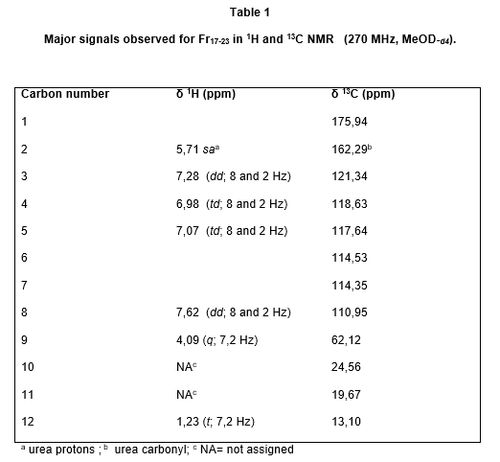Bioquímica
Urinary Elimination of Ortho-substituted Benzene in Rats Taking Bauhinia megalandra Leaves Aqueous Extract and Changes on glycaemia and glycosuria
Results
Identification
of the compound eliminated by the urine. -
The fraction soluble in acetone from the urine of the experimental animals
showed a blue-gray spot at 365 nm in TLC with an Rf of 0.28 that was not
present in the urine of the control rats nor in the B. megalandra leaves aqueous extract. The blue-gray compound was
partially purified by using column chromatography and differential solubilization
and was partially identified by 1H and 13C NMR.
In the 13C spectrum
(Table 1) six signals between 122 and 110 ppm were observed and they were
assigned to benzene carbons being two of them probably quaternary. Furthermore
signals were observed at: 175.94 ppm that may correspond to a carboxylic acid,
ester or amide; 162.29 ppm that correspond to the carbonyl carbon of the urea;
a signal at 62.12 ppm and three signals of aliphatic carbons at 24.56, 19.67
and 13.10 ppm.
In the 1H spectrum
(Table 1) many signal were observed, however certain of them are of interest:
four signals at low field, coupled between them at 7.7 and 6.9 ppm that
correspond to aromatic protons and define the substitution pattern AA'BB'.
Additionally, a broad and intense singlet was observed at 5.7 ppm that
corresponds to the urea protons. At high field a triplet was observed at 1.23
ppm (J= 7.2 Hz) that is coupled to a
quartet in 4.09 (J= 7.2 Hz) that
defines as an ethoxy (EtO-), one of the substituent groups. 
The coupling pattern in the
aromatic region of the 1H NMR coincides with a benzene ortho-substituted
and it is explained thus: two doublets of doublets centered at 7.62 and 7.28
ppm with a coupling ortho-meta (J= 8;
8 and 2 Hz). Additionally, a singlet at 7.9 ppm was observed, possibly these
signals can be attributed to an aromatic system poly-substituted. A possible
structure that fits the majority of the NMR signals could be:

Changes in glycaemia and glycosuria during the
administration of the B. megalandra leaf
extract. – As it can be observed in Table 2 the administration of the plant
extract produces a decrease of approximately 9 % in the glycaemia which was
statistically significant at p< 0.01. On the other hand, the 24 h.
glycosuria increases by approximately 3.6 times this being statistically
significant at p< 0.005 The
experimental rats received B. megalandra aqueous
leaves extract in place of drinking water for 7 days. During a 24 h fast period
the urine was collected, after which a sample of blood was taken, the glucose
was measured in the plasma and urine by the GOD/POD (10). The values
represent the mean ± standard deviation. The differences between controls and
experimental was significant at p< 0.01 for the glycaemia and p< 0.005
for the glycosuria. |